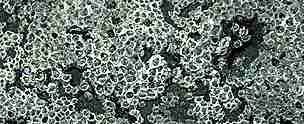 Barnacles look much like miniature volcanoes and are found attached all over rocks around the high tide mark all around our coasts.
Barnacles look much like miniature volcanoes and are found attached all over rocks around the high tide mark all around our coasts.
Barnacles are crustaceans. They are unusual animals as they classed as arthropods, and are most closely related to decapod crabs, prawns, and crayfish (lobsters). These crustaceans have jointed legs and shells of connected overlapping plates. Instead of crawling after food, they glue themselves to rocks, ships, warves, and wait for food to wash by.
The barnacle can live in clusters of up to several thousands, and will live out its entire life inside its shell firmly attached to one spot on the rock. They cannot move about and are totally dependent upon the high tides to bring all the things that it needs to survive. They very occasionally attatch to wood, and are not usually found in estuaries.
Interestingly, many species of barnacle live quite high on the shore and may only be covered with water for only a few hours each day. For the rest of the time they must endure the elements of the hot sun and people tramping over them.
There are several species of barnacle, some being the Goose Barnacle, or the Large Pink Barnacle, but the most common would be the honeycomb or common small barnacle (pictured). This small barnacle is a small barnacle with four main non-porous shell plates. Other species might be made up from six or eight calcareous plates. They like many other types often occur together in vast numbers, and may be so crowded together that it is difficult to distinguish separate plates. The top entrance is covered by another two plates.
Baracles are around 5-8 mm (.19"-.31") wide, 5-19 mm (.19"-.74") high, and are normally a grey to whitish colour though darkining to a brownish colour in more eroded specimens.
When barnacles are underwater or when a wave washes over them they feed, the two top plates open they reach out little feathery barbed legs to strain out plankton, and at the same time absorb oxygen.
Barnacles are able to fertilise one another. Barnacles are hermaphrodytic, which means that a single animal has both male and female parts.
When ready to reproduce, an adult barnacle uncoils its long tubular penis and extends it out through the operculum to search for a nearby receptive neighbour. When the sperm is transferred the barnacle's fertilized eggs soon hatch into larva. Then they leave the parent shells. A single adult barnacle may release over 10,000 larvae.
These larvae are called (naupli). These numerous naupli are then released into the water as plankton. As the nauplius grows and develops it goes through several moult stages, until it reaches the cyprid larvae stage. At this stage when everything is right, the cyprid larvae uses special natural adhesive (glue) through cement glands in its antennae to attach itself to the rock.
The cyprid then moults and rotates its body so that the appendages now face upward. They now modify to form long and feathery cirripeds, these wave through the water for planktonic food. The cyprid carapace is a structure around which the barnacle secretes its fixed shell plates as walls, and the four moveable plates on top, which open to allow the cirri to gather food.
Predators and dangers to barnacles would be worms, snails, sea stars, some fish, some shorebirds, and oil spills.